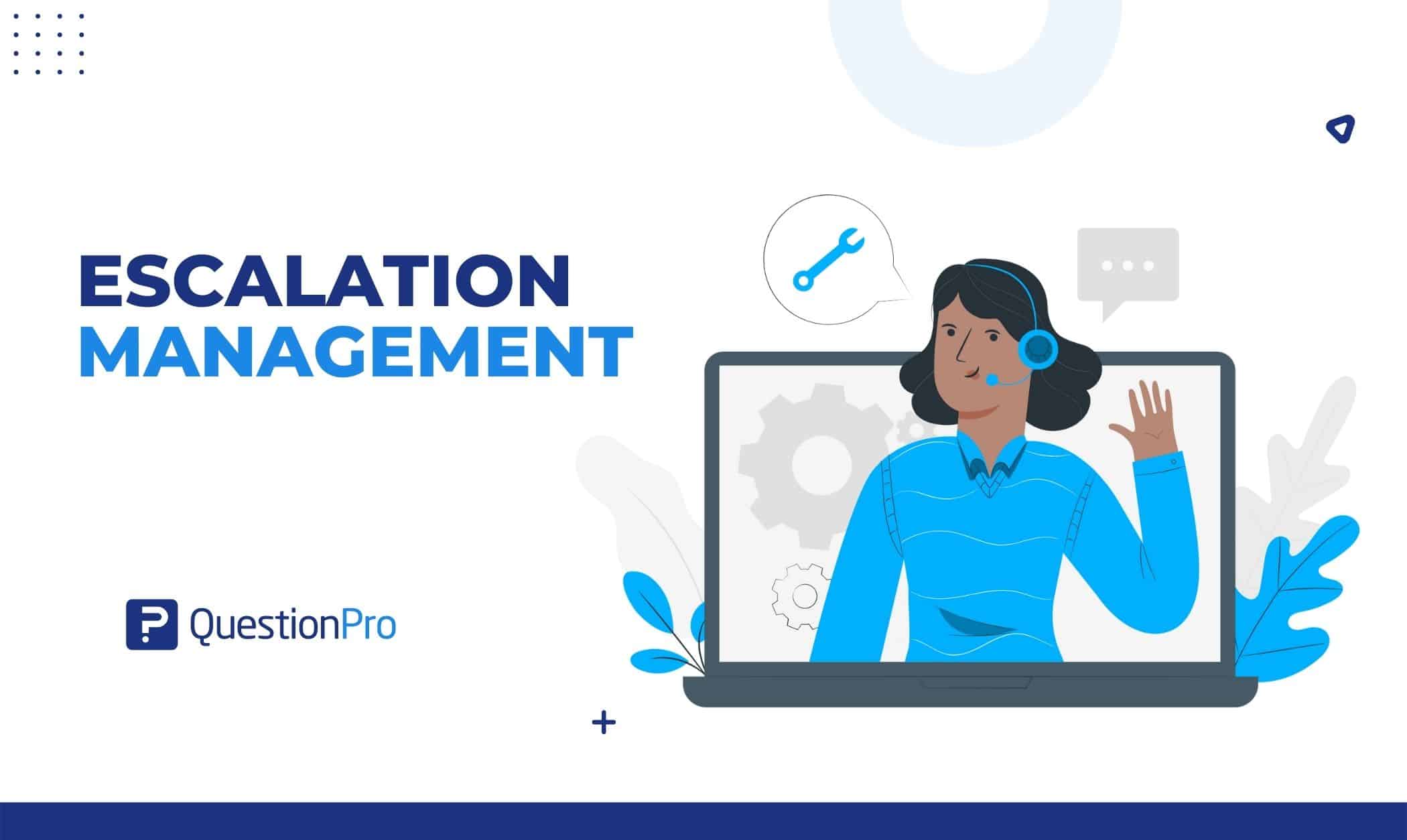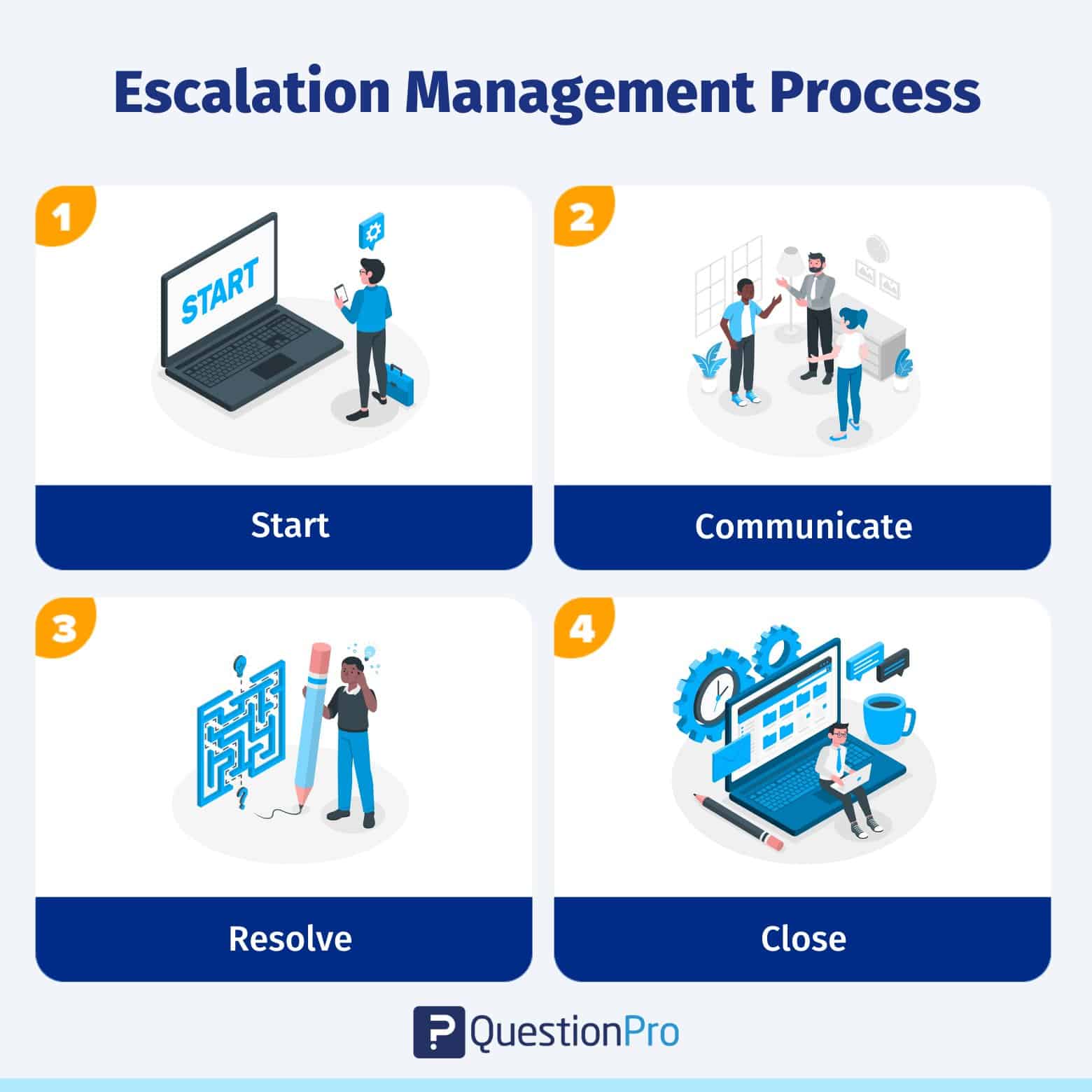
Successful escalation management can shorten the time it takes to solve problems and increase customer satisfaction. Building a successful business requires maintaining satisfied customers and providing them with the most outstanding experience possible. That’s why it’s so important for your customer support teams to deal with every single complaint quickly and do their best to resolve each and every one of them on the first try.
Here, you’ll learn about the procedure and varieties of escalation management. Also included is advice on how to handle situations that escalate.
What is escalation management?
Escalation management prioritizes customer support team issues, evaluates problems based on severity, and ensures the appropriate representatives are assigned to handle them.
Managing escalations is a key part of keeping more customers. You need to keep your customer response time low and give your finest representatives authority over their cases. More people will be happy with the outcome.
Sometimes an agent can’t address a customer’s problem. Or they may be asked a question beyond their knowledge. In these circumstances, the question or concern of the customer must be passed up the chain of command.
Types of escalations
Escalation methods can be divided into three categories:
- Functional escalation
- Hierarchical escalation
- Automatic escalation
It is possible that your companies will require the usage of either one, the other, or all of these options, depending on the customer’s problem.
1. Functional escalation
Functional escalation happens when a support agent is unable to resolve a customer’s request within their normal area of responsibility. The most common reason for this is that the requested service is outside of their area of expertise.
For example, Suppose a consumer calls with a question about a payment failure, and the representative they’re speaking with doesn’t know the answer. In that case, the agent will escalate the inquiry to someone in the finance team. It’s a functional escalation.
2. Hierarchical escalation
A hierarchical escalation happens when a customer’s request necessitates the involvement of a higher-ranking employee, such as a manager or supervisor.
This type of escalation is common when customer service agents are at a loss for how to respond to a customer’s demands owing to corporate policy or other restrictions. An upper-level manager or supervisor may be able to make exceptions or provide extra resources to help with complicated client concerns.
3. Automatic escalation
Companies today frequently use service level agreements (SLAs) to promise their clients a specific minimum standard of service.
For example, If a corporation promises to respond to client inquiries within six hours or less, that means it must do so. This signifies that such businesses’ target time for answering consumer questions is 6 hours or less. If this isn’t done, things will escalate automatically.
The team’s managers are automatically alerted whenever a customer service team-level agreement (SLA) is breached. When a client escalates a problem, they want them to take charge and get to work fixing it before it damages the company’s reputation.
LEARN ABOUT: Client Management
Escalation management process
You need escalation management processes for escalating issues if you want to manage escalation effectively. You can resolve client issues more efficiently and streamline the decision-making process by following the steps:

Step 1: Start
With a well-defined escalation procedure in place, you can rest assured that pressing customer concerns won’t go ignored. A simplified escalation procedure should follow these steps:
- Create an escalation: Sets off the escalation based on the specified criteria. These may involve funding, personnel, tools, technical features, and functionality.
- Provide details: If the outage is affecting many clients, this section provides the following details
- List of customers impacted
- Services impacted
- Linked records
- Problem records
- Contact information contained within records
- Etc.
Step 2: Communicate
- Communicate: Within the first hour, inform the internal stakeholders and impacted customers about the escalation that has occurred. Perform an update on the status of the escalation activities after a specific time.
- Create an action plan: Develop a comprehensive action plan depending on the data in the record.
Step 3: Resolve
- Adjust the action plan: Make necessary changes to the action plan in light of new information and revisions to the technical resolution plan provided by the experts. If the resolution cannot be reached within a particular time of the escalation, involve more parties.
- Deploy a task force: Establishes a task force to address the technical event and presents a plan for its resolution on the technical level.
- Declare a resolution: The task force is suspended when the escalated event has been declared resolved by the manager. The de-escalation architect checks and notifies the internal and external parties of the resolution. A customer engagement executive will ensure that the impacted customer can access the disrupted services.
Learn More: Complaint Resolution
Step 4: Close
- Close related incidents: Ensure any open issues the customer brought up have been resolved.
- Ask for a root cause analysis (RCA): You may ask for an RCA. If necessary, start managing the issues as soon as possible.
- Provide external root cause analysis: The problem coordinator should submit the findings of the problem record as an internal RCA. Create a final, customer-facing RCA by combining this internal RCA. The customer engagement executive will then share the final RCA with the customer.
Significance of escalation management
Escalation management plays a crucial role in modern business practices for several reasons:
Customer retention
Promptly addressing escalated issues helps retain customers by demonstrating dedication to problem-solving and customer happiness.
Damage control
Timely resolution prevents minor problems from escalating into major crises, protecting the company’s reputation.
Resource optimization
By involving specialized personnel only when necessary, resources are efficiently allocated, reducing unnecessary workload.
Continuous improvement
Feedback from escalations helps identify recurring problems, allowing organizations to implement improvements and prevent similar issues in the future.
Enhanced communication
It promotes better communication within the organization and with external stakeholders, fostering collaboration and teamwork.
Best practices for effective escalation management
A customer with a satisfactory escalation resolution is more loyal than one without problems. Good customer care might impress a troubled client. Think of an escalation as a chance to enhance your relationship with the consumer and keep them for life. Here are some best practices you may follow:
- Establish SLAs for your team to follow.
- Develop well-defined escalation systems and procedures.
- Pay close attention to the feedback provided by the clients.
- Imagine that you are the customer and put yourself in their position.
- Understanding the value that each customer brings to your company.
- Direct customers to the appropriate individual from the beginning.
- Quickly bring each escalation to a close.
- Improve future encounters with customers by taking lessons from escalations.
And then again, if we go into details, there are more best practices that can be followed, like:
Define clear escalation paths
Establish well-defined and documented escalation paths that outline how issues should be escalated, who the responsible parties are at each level and the criteria for escalation. This clarity ensures that problems are directed to the appropriate personnel and prevents delays or confusion.
Set escalation timeframes
Specify timeframes for each escalation level to ensure that issues are addressed in a timely manner. This helps prevent problems from languishing without attention and shows customers that their concerns are taken seriously.
Empower frontline support
Provide frontline support teams with adequate training, resources, and decision-making authority to handle as many issues as possible at their level. Empowering them to resolve common problems efficiently can prevent unnecessary escalations.
Transparent communication
Maintain open and transparent communication channels throughout the escalation process. Keep all parties involved informed about the status of the issue, progress made, and expected timelines for resolution. Communication helps manage expectations and reduces frustration.
Escalation documentation
Record all relevant details of the escalation, including the problem description, actions taken, and communication history. Proper documentation assists in analyzing patterns and tracking the resolution process.
Review escalation criteria regularly
Periodically review and update the escalation criteria to ensure they align with current business needs and customer expectations. As the organization evolves, so should the customer service escalation process.
Collaborative approach
Promote collaboration between different teams involved in the escalation process. Encourage knowledge sharing and cross-functional training to improve the overall efficiency of the customer escalation management process.
Continuous improvement
Gather feedback from both internal and external stakeholders after each escalation to identify areas for improvement. Use this feedback to refine the escalation process and prevent similar issues in the future.
Avoid the blame game
Foster a culture where employees are not afraid to escalate issues without fearing blame or reprisal. The focus should be on problem-solving rather than pointing fingers.
Senior leadership support
Ensure that senior leadership is aware of the importance of customer escalations management and actively supports the process. Having their endorsement reinforces the significance of timely issue resolution.
Measure escalation metrics
Implement key performance indicators (KPIs) to track the effectiveness of the escalation management process. Measure metrics such as time to resolution, escalation frequency, and customer satisfaction levels.
Escalation training
Provide training to employees involved in this type of management. Equip them with the necessary skills and knowledge to handle escalated issues professionally and efficiently.
Conclusion
Understanding the level of customer service you must provide is necessary for escalations management success. You can create a simple, straightforward response process that guides customers to successful results. These capabilities enable your customer success team to proactively avoid escalations or manage them more effectively when they occur.
A uniform platform orchestrates each step in the incident management process to manage an incident properly. QuestionPro CX is a tool that specialists have developed to fulfill unique needs for implementing customer-centric strategies.
You can assess each interaction between your customers and your brand using QuestionPro CX. It will assist you in managing escalation. You may get real-time feedback and learn how satisfied your customers are.
If you’re interested in our product or have questions, test it for free and register so a customer service agent may contact you.







